At first glance, Brussels seems famous mainly for chocolate, beer, mussels and Chips. However, the cuisine of Belgium is very diverse. At the same time, you can find all kinds of international cuisine restaurants in the Belgian capital. In this article, you will find a guide to navigate through frites and gaufres in search of the best typical food in Brussels.
Table of Contents
The best dishes to taste in Brussels
Belgian gastronomy is diverse, with countless regional varieties and French and Flemish influences. The proximity to France and the Netherlands has influenced not only the language – French and Dutch are spoken in Belgium – but also the cuisine and typical Belgian dishes.
PLAN YOUR TRIP TO BRUSSELS
Make the most of your trip to Brussels by purchasing the Brussels City Card online. With access to the city’s top museums and free public transport, it’s the smartest way to explore the city and save money.
To stay connected in Brussels, purchase an Airalo eSim online for phone and data coverage during your trip to Belgium.
During a trip to Brussels, you should try the meat dishes, characterised by slow cooking, the very fresh fish from the North Sea, waffles, here called gaufres, sold by the countless food trucks, and devote a lunch to moules frites, a pot of mussels accompanied by chips. This dish is very popular both in Belgium and in neighbouring France.
Brussels sprouts: the great absentees
Despite the name, these sprouts are grown not only in Brussels and Belgium but throughout central and northern Europe because they grow well in cold climates. You can undoubtedly find Brussels sprouts in some restaurants but don’t expect to find them everywhere. I have yet to see them on any restaurant menu during my travels.
Frites: fried potatoes in the Belgian way
French fries, called frites in French, are a veritable institution in Brussels. Although very common in northern European street food, Brussels fries are distinguished by being cut into wider sticks and served in the classic cardboard cone with a choice of sauces.
The taste is more savoury due to the double-frying method used. The fresh potato sticks, never frozen, are fried a first time at 150 degrees, drained and fried again at 180 degrees to achieve the perfect browning on the outside and crispiness while keeping the inside soft.
According to tradition, frites should be served in a paper cone covered with sauces, although trays often replace the cone. In the best fry shops, the dressings are maison, i.e. prepared fresh, and can occupy an actual menu with twenty or more choices. You can add cold or hot sauces, from classic mayonnaise to the more original chinoise or samurai.
To find the best fry shops in Brussels, you can check out which businesses vie for the ‘meilleur frituriste’ title. For instance, Maison Antoine in the Etterbeek district has won the ‘Frituriste de l’année’ award and is consistently cited among the best fried-food shops, as is Frit Flagey in the Ixelles district.
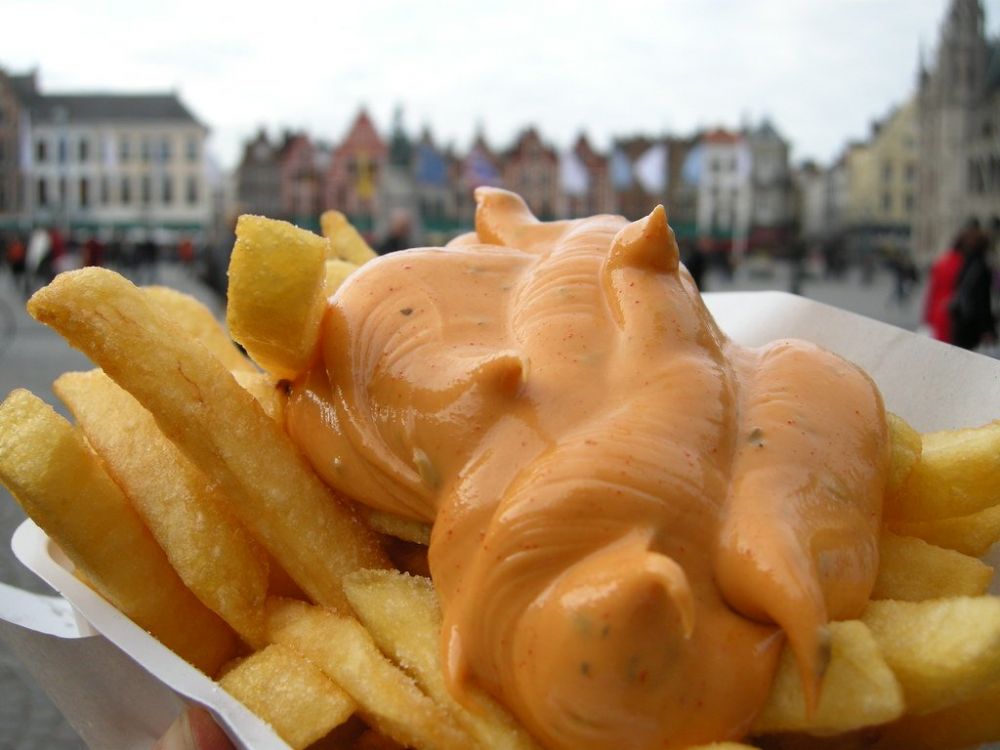
Moules frites (fried mussels)
On a trip to Brussels, mussels with fries are a must-try. Indeed, moules-frites have, over time, become the dish of Belgian national identity and are served everywhere in Belgium, from the North Sea coast to the Ardennes. Mussels and fries are also the speciality of the Belgian chain Chez Léon, which has its main restaurant in Brussels.
Mussels in Belgium are cooked in various ways and one of the most popular is in casserole with garlic, parsley, celery and other vegetables, accompanied by chips. ‘Moules en casserole’ are usually marinara style, with cream, white wine or cheese and a Belgian blond beer.
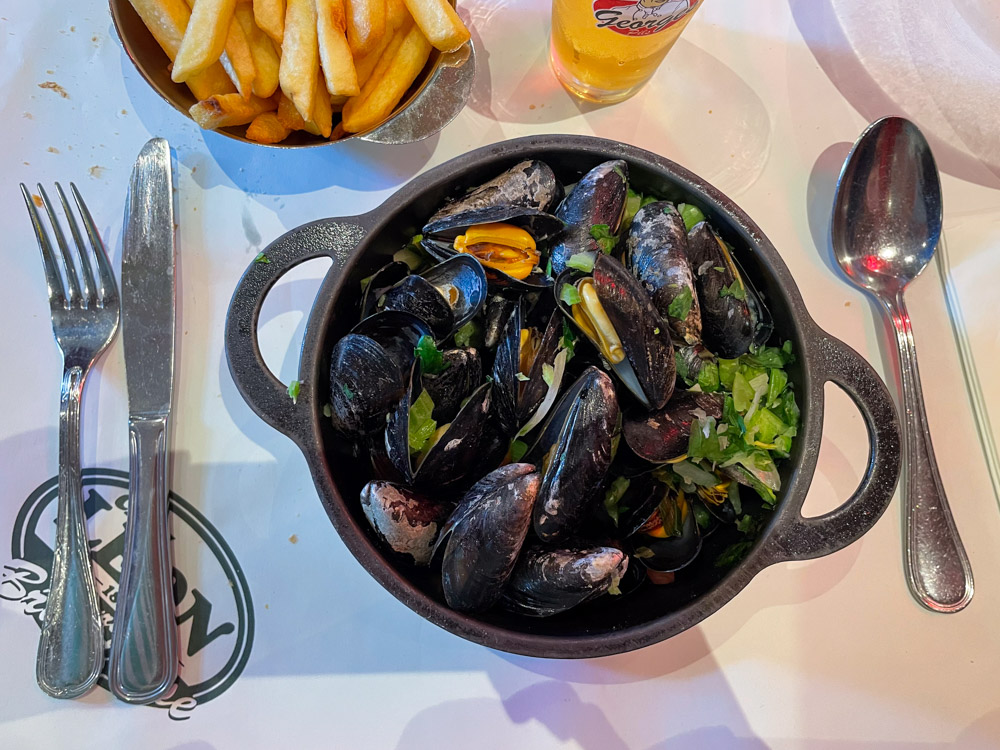
Seafood and shellfish
The proximity of Belgium to the North Sea makes it an excellent country for fish and seafood lovers. Place Sainte-Catherine is the ideal spot to relish these delicacies. This beautiful rectangular square, once a fish market in Brussels, is now home to several seafood restaurants and fish bars. You can easily spot them due to their large lobster-shaped neon signs.
If you are not afraid of the cold, you can enjoy a meal or an aperitif outdoors with seafood and a glass of white wine at Noordzee La Mer du Nord, a fish market that serves freshly cooked dishes. I highly recommend trying the coquilles Saint-Jacques (scallops), fish soups, snail soups (escargot), and fresh fish grilled to perfection.
Gaufre (Waffle)
Waffle trucks are a popular attraction in Brussels. Waffles, known as gaufres in Belgium, are a typical Belgian treat, but similar variations are also enjoyed throughout Europe. They are made with eggs, milk, flour, and brewer’s yeast and are freshly baked in special honeycomb plates to achieve a crispy exterior and a soft interior. The traditional version is plain, but tourists are often tempted by fancier toppings such as cream, chocolate, and fruit.
Prices for gaufres start at €1.50 for the basic version in food trucks but generally cost a few euros. I recommend trying them at the small truck near the arch of the Parc du Cinquantenaire. It is a less touristy spot and most popular among locals, and their waffles are delicious.
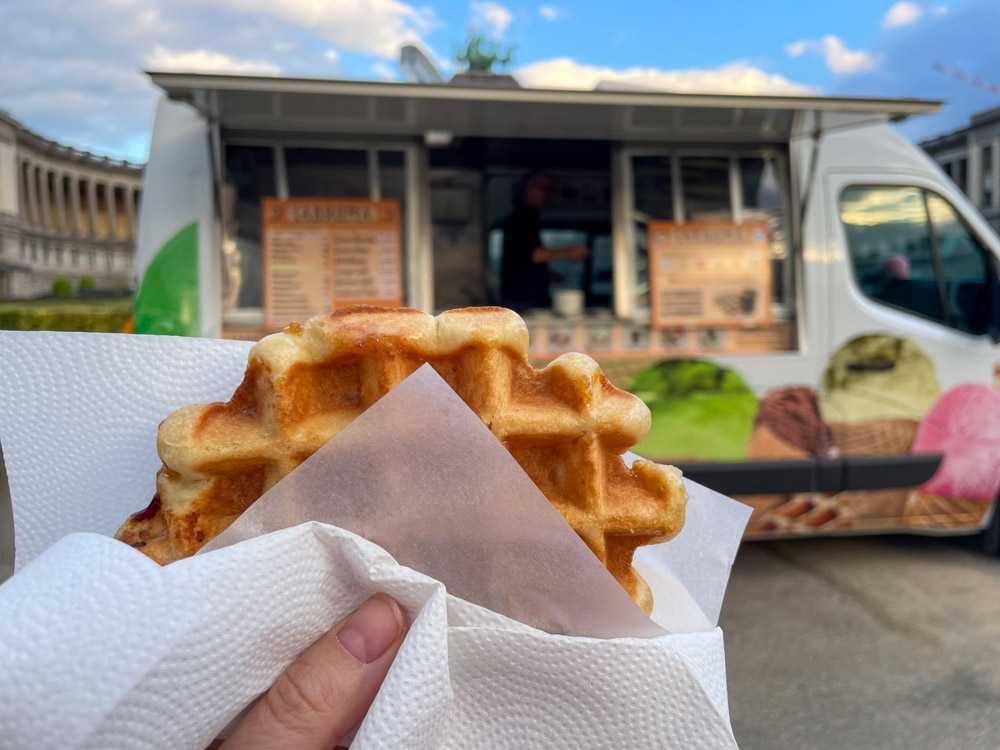
Meat dishes: carbonade and pork knuckle
In Brussels restaurants you can try different typical meat dishes. Some dishes, such as pork knuckle, will at first glance remind you of German cuisine, but are actually much more like French cuisine.
A classic Belgian meat dish is carbonade flamande, a tasty beef stew with flour, beer and onions, according to the traditional Flanders recipe. The name carbonade comes from the French word charbon (charcoal) because this dish was originally slow-cooked over the fireplace embers.
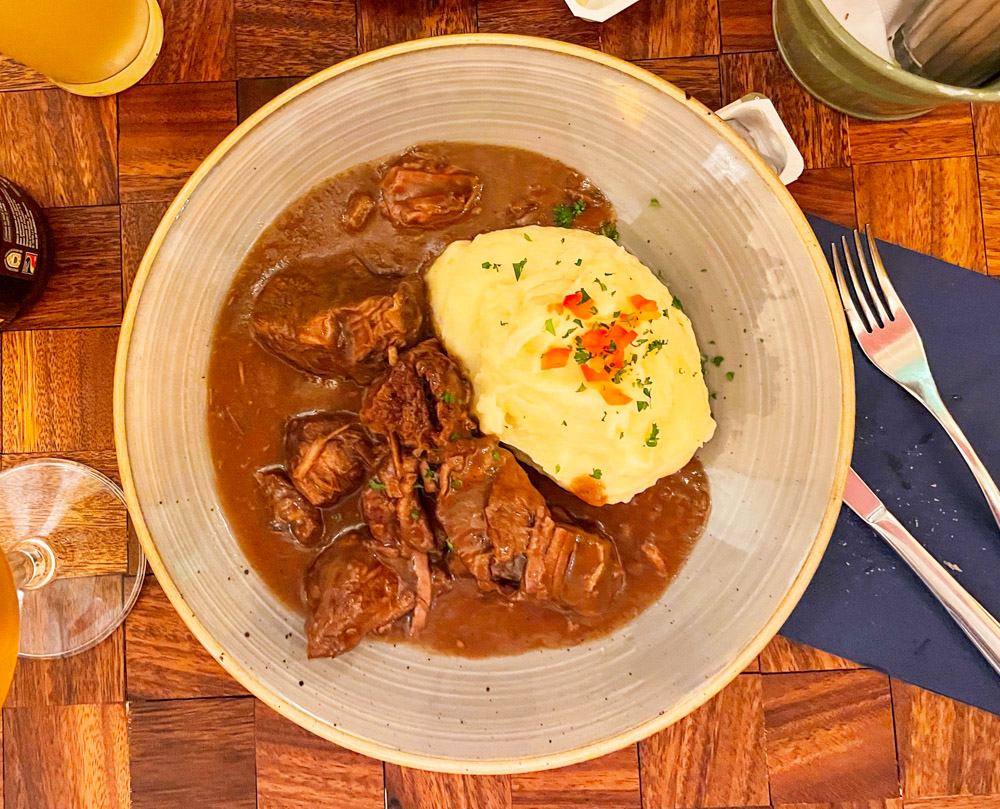
Another Flemish dish is jambonneau, braised pork knuckle. The taste is delicate, but the courses are so plentiful that I recommend sharing the meat dishes with your fellow travellers.
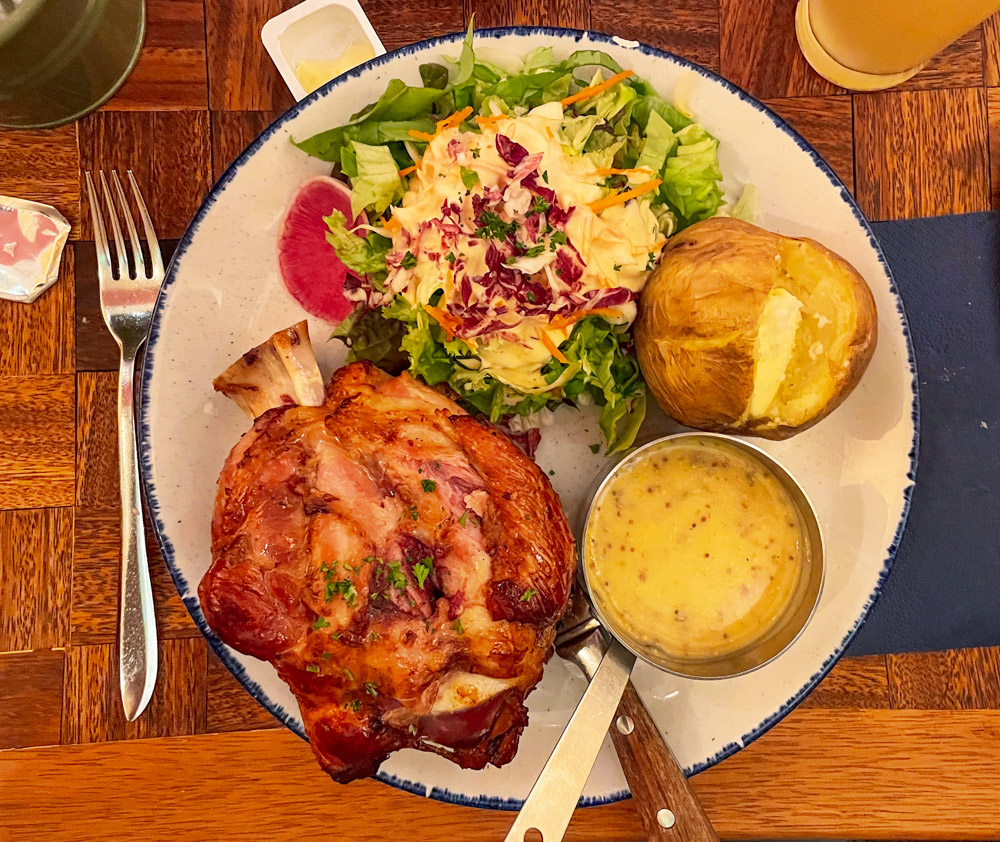
Stoemp: potato side dish
The meat dishes of Belgian cuisine are often accompanied by stoemp, a puree of potatoes and other vegetables such as turnips or carrots. Originally a popular peasant dish, today stoemp is also popular with tourists. You can almost always find it as a side dish for sausage or stewed meat in Brussels restaurants. If you are vegetarian, you can ask for it on its own.
Chocolate
During my first visit to Brussels, I was amazed by the numerous chocolate shops in the city centre. Belgian chocolate is a renowned product, and the city is home to many famous brands such as Godiva, Neuhaus, Leonidas, and Côte d’Or. The shops offer a variety of chocolate products, including chocolates, pralines, bars, flakes, and even hot chocolate in winter.
Pierre Marcolini is a high-end chocolate shop that stands out among the competition with its refined and sophisticated combinations. Choco-Story, the Brussels Chocolate Museum, is just a few steps away from the Grand Place and is worth visiting.
The praline is the typical Brussels chocolate, a staple of all Belgian chocolatiers and confectioners. They always propose new combinations, such as lime-flavored pralines. A box of mixed chocolates is a classic Brussels souvenir you can buy for yourself or your friends and relatives back home.
What to drink in Brussels: Belgian beer and abbey beer
Belgium takes pride in their beer culture, which UNESCO recognized as an Intangible World Heritage Site in 2016. As the world’s leading beer producer, Belgians consume an average of 100 litres of beer every year.
In Brussels, almost all bars and restaurants serve a variety of Belgian beers. Monks brewed their brands like Chimay, Orval, Rochefort, Westmalle, Westvleteren, and Achel since the Middle Ages. Other popular brands are Leffe, Artois, Chouffe, Kwak, Kriek, and Duvel. Beer is not just served as an accompaniment to every meal but is also an ingredient in various traditional meat and fish dishes.
To taste authentic Trappist beers, you must visit the monasteries in person. Many microbreweries in Belgium sell their beer only in the place of production. However, in Brussels, you can still discover new brands and flavours. For instance, I recommend trying the world-famous cherry Kriek or exploring new brands at the Delirium Café. This pub is famous for having over 2,000 beer labels on the menu.
International cuisine in Brussels
Brussels is a cosmopolitan city that offers a variety of dining options. You can try authentic Belgian cuisine and dishes from all over the world. Vietnamese cuisine in Brussels is especially noteworthy.
However, I recommend trying African dishes if you feel adventurous and want to explore new flavours. The Matongé district is home to a significant Congolese community where you can savour typical African cuisine.
How much it costs to eat in Brussels
Despite being a European capital, Brussels is affordable compared to other northern European cities. You can spend €15-20 for a course in a typical restaurant, but if you are travelling on a budget you can eat in kiosks and friteries for a few euros.
To save money, you can choose restaurants like Chez Léon, which offers an inexpensive moules frite menu, and children eat free for every adult who orders from the regular menu. Unlike in France, in Belgium, bringing a complimentary carafe of water to the table is not usual. However, beer is delicious and costs less than water, so you will probably end up drinking beer everywhere.
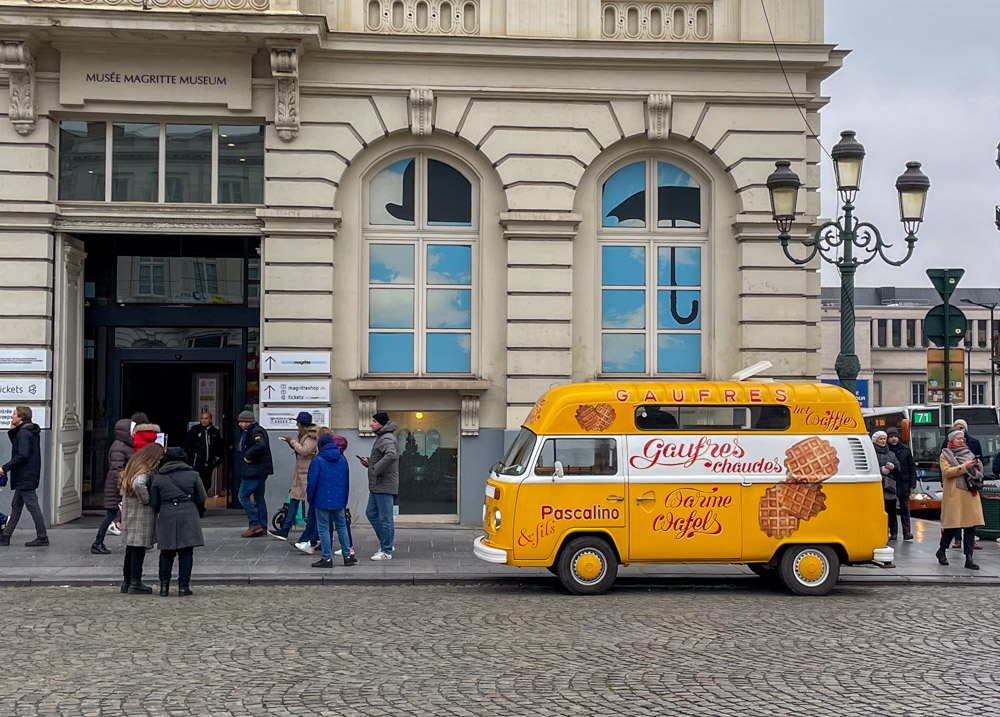
Where to eat in Brussels
In Brussels, just like in the rest of northern Europe, there are plenty of options to dine outdoors, even during winter. You can easily spot food trucks and kiosks selling crispy gaufres almost everywhere. The best ones are usually the busiest.
Apart from these, there are also a variety of typical and international restaurants in Brussels. If you’re looking for a great lunch or Sunday brunch, the museum restaurants offer delicious menus at reasonable prices.
If you plan a trip to Brussels, try some of the following places. These are kiosks and restaurants that I have personally tried, and I can vouch for their quality.
Maison Antoine
For 65 years, Maison Antoine has been preparing the best fries in Brussels. The kiosk is open every day from 11.30 am to 1 am, but people are already queuing from 11 am. I recommend getting the cone of petite frites with homemade tartar sauce, called tartare maison, and carbonade sauce served hot because they are delicious.
In addition to fries, you can choose from various types of croquettes, burgers or mitraillette, a typical Belgian sandwich consisting of a baguette stuffed with meat, fries and sauces.
Maison Antoine
Place Jourdan, 1
1040 Etterbeek, Bruxelles
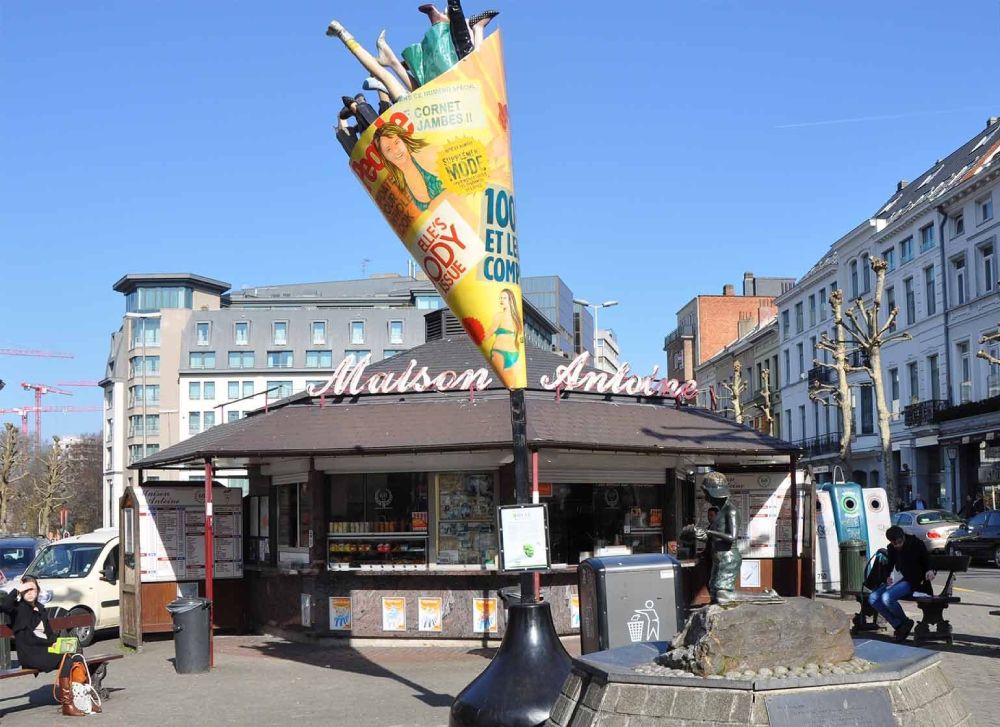
Noordzee La Mer du Nord
The Noordzee La Mer du Nord is a fish shop famous for fresh fish delivered daily and carefully selected, but also for its fish bar, where you can enjoy delicious seafood and fish soups with a good glass of white wine.
The dishes are so good that the outside tables on the square are often very crowded and you have to queue to order. However, it is worth it because the dishes are freshly cooked in front of you. Your name is called as soon as your order is ready, and you can enjoy grilled fish and seafood or soups alongside more elaborate dishes.
Noordzee La Mer du Nord
Place Sainte-Catherine, 50
1000 Bruxelles
Fin de Siecle
The Fin de Siecle restaurant is in the centre of Brussels, perfect for enjoying the best dishes of typical Belgian cuisine. The décor is characterised by wooden furniture and many tables that create a pleasant, informal atmosphere. The portions are all very generous, and the food is all delicious.
The main dishes on the menu are carbonade with beer, pork knuckle with mustard, stoemp with sausage, and much more. While specialising in typical Belgian meat dishes, the Fin de Siecle restaurant has many vegan and vegetarian options.
Fin de Siecle
Rue des Chartreux, 9
1000 Bruxelles
Chez Léon
Chez Léon is the temple of fried mussels in Brussels. It is a restaurant that offers moules frites in 14 different ways, typical Belgian food, and a free menu for children. You might have heard of this name because it is a chain spread throughout Belgium and France.
However, Chez Léon is historically located in Brussels and opened in 1893. The main restaurant is located in the historical centre of Brussels and is quite large. However, on weekends and evenings, you might find queues for food because it is so popular.
The restaurant has a lively and comfortable atmosphere, with Belgian-themed decor on the walls and furniture. Tintin and Hergé drawings, murals with mussels referencing Belgian artist René Magritte, a Manneken-Pis statue, Smurf sculptures, and framed comics are all visible.
Chez Léon
Rue des Bouchers, 18
1000 Bruxelles
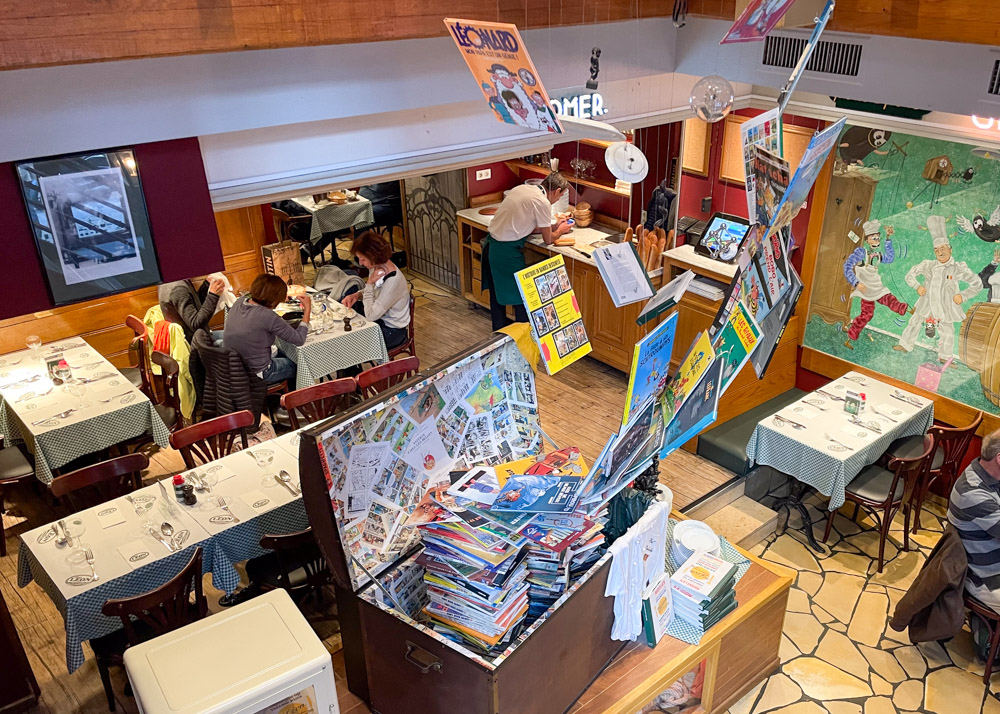
Delirium Café
The most famous brewery in Brussels, and probably the whole world, is the Delirium Café, known for the incredible number of beers on the menu, over 2000, which is why it holds the Guinness World Record. Today, the Delirium Café is a franchise spread worldwide, especially in France, but the main venue remains in Brussels.
The name comes from the Delirium beer, which shares the pink elephant symbol, and the brewery’s interior is entirely decorated with a beer theme. You can see thousands of beer and brewery souvenirs, such as placemats, advertising plaques, glasses and trays.
At the Delirium Café, you can enjoy Belgian beers such as Trappist or fruity beers and beers from all over the world, including unusual beers such as those flavoured with chilli, coconut, chocolate and even banana. The brewery is just a few steps from the Jeanneke Pis statue, so you can plan your sightseeing tour of the city centre to stop at this famous brewery.
Delirium Café
Impasse de la Fidélité, 4
1000 Bruxelles
Where to stay in Brussels
I have visited Brussels many times, and I can confidently say that the city offers a wide range of accommodation options to suit different travel styles. If you are looking for a hotel in the city centre, the Pillows City Hotel Brussels Centre is an excellent choice. It is located just 100 metres from Brussels Central Station and within a five-minute walk of the Grand Place and the Manneken Pis statue, making it ideal for exploring the city on foot.
Right in the heart of Brussels, Made in Catherine is located on Place Sainte-Catherine, only a ten-minute walk from the Grand Place. This small hotel is particularly appreciated for its fantastic buffet breakfast and its lively yet authentic neighbourhood.
In the European Quarter, for an especially romantic stay, Faubourg 21 is a refined five-star hotel offering a spa, wellness centre and a terrace. It is a great option if you want to combine sightseeing with relaxation in an elegant setting.
If you prefer staying in an apartment, Teddy Picker offers well-designed studios with a garden or terrace. The property also features a family-friendly restaurant serving Belgian and international cuisine for lunch and dinner, including vegetarian and vegan options.
In Brussels, there’s something for everyone, from traditional Belgian cuisine to international delights, and this article provides you with some great tips on where to find the best food in the city. Feel free to share your favourite restaurant and dish in the comments below; I always seek new recommendations. I look forward to returning to Belgium to try new delicacies accompanied by great Belgian beer.

6 comments
The Food Explora in me was drooling while reading your food blog. The food and meals look delicious. Never thought of visiting Belgium, but your blog has won me over. I assume Belgium is also a fun and adventurous place to visit. Thanks for sharing.
Thank you! I spent most of my time in Belgium in Brussels, a great place for foodies. You can find a range of local and international specialities, as well as a lot of craft beers. I also enjoyed visiting the beaches in Belgium, similar to those in the UK. Additionally, many tourist cities in Flanders are worth visiting!
These all look like such delicious dining options in Brussels. I’m hungry thinking about all these options – especially the Waffle trucks! Yum!
The waffle truck is an experience in itself! It’s pretty touristy, to be honest, but I loved it!
Great guide! I’ve always loved some of these Belgian food. In fact, one of my fond memories when it comes to visiting Belgium is their food.
I have to confess that sometimes I choose destinations for the food!